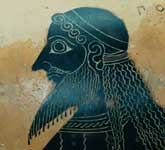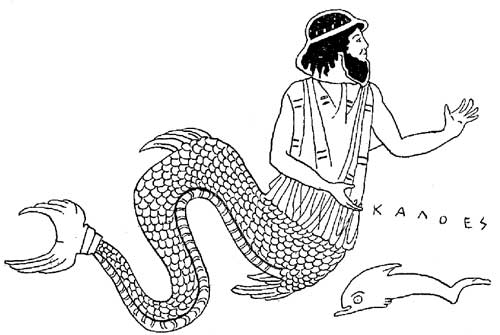The ancient Greeks had a large number of sea gods.
The philosopher Plato once remarked that the Greeks were like frogs sitting around a pond - their many cities hugging close to the Mediterranean coastline from the Hellenic homeland to Asia Minor, Libya, Sicily and Southern Italy. It was natural, therefore, to develop a rich variety of aquatic divinities. The range of Greek sea gods of the classical era range from primordial powers and an Olympian on the one hand, to heroized mortals, chthonic nymphs, trickster-figures, and monsters on the other.
These gods are valuable to study for several reasons. First, because the sea loomed so large in Greek life of all periods, a great deal of moral, cosmological and mythopoetic thought is wrapped up in its divinities. Second, the sheer variety and strangeness of the Greek sea gods seem to hold forth hints about the pre-history of Greek religion.
Types of Sea-Gods
Primordial powers
Some early Greek thinkers made the sea-divinities into primordial powers. Oceanus and Tethys are the mother and father of the gods in the Iliad, while the Spartan poet Alcman made the sea-nymph Thetis a demiurge-figure. Orpheus's song in Book I of the Argonautica hymns the sea-nymph Eurynome as first queen of the gods, as wife of the ocean-born giant Ophion.
The pre-Socratic cosmogony of Thales, who made water the first element, may be seen as a natural outgrowth of this poetic thinking.
The primacy of aquatic gods is reminiscent of, and may have been borrowed from, ancient Near Eastern mythology - where Tiamat (salt water) and Apsu (fresh water) are the first gods of the Enuma Elish, and where the Spirit of God is said to have "hovered over the waters" in Genesis.
Poseidon and the Heroes

Poseidon, as god of the sea, was an important Olympian power; he was the chief patron of Corinth, many cities of Magna Graecia, and also of Plato's legendary Atlantis.
Historians of ancient religion generally agree that Poseidon was a horse-god before he was a sea-god. As such, he was intimately connected with the pre-historic office of king - whose chief emblem of power and primary sacrificial animal was the horse. Thus, on the Mycenean Linear B tablets found at Pylos, the name PO-SE-DA-WO-NE (Poseidon) occurs frequently in connection with the wanax ("king"), whose power and wealth were increasingly maritime rather than equestrian in nature. Surprisingly, Poseidon's name is found with greater frequency than that of Zeus (DI-U-JA), and is commonly linked (often in a secondary role) with Demeter (DA-MA-TE).
When the office of wanax disappeared during the Greek Dark Ages, the link between Poseidon and the kingship was largely, although not entirely, forgotten. In classical Athens, Poseidon was remembered as both the opponent and doublet of Erechtheus, the first king of Athens. Erechtheus was given a hero-cult at his tomb under the title Poseidon Erechtheus.
In another possible echo of this archaic association, the chief ritual of Atlantis, according to Plato's Critias, was a nocturnal horse-sacrifice offered to Poseidon by the kings of the imagined island power.
In keeping with the mythopoetic equation between horsemanship and seamanship, the equestrian heroes Castor and Pollux were invoked by sailors against shipwreck. Ancient Greeks interpreted the phenomenon now called St. Elmo's Fire as the visible presence of the two demigods.
Old Men and Nymphs

Nereus from a Vase painting
Several names of sea gods conform to a single type: that of Homer's halios geron or Old Man of the Sea: Nereus, Proteus, Glaucus and Phorkys. Each one is a shape-shifter, a prophet, and the father of either radiantly beautiful nymphs and hideous monsters. Nymphs and monsters blur, for Hesiod relates that Phorcys was wed to the "beautiful-cheeked" Ceto, whose name is merely the feminine of the monstrous Cetus, to whom Andromeda was due to be sacrificed. Each appearance in myth tends to emphasize a different aspect of the archetype: Proteus and Nereus as shape-shifters and tricksters, Phorcys as a father of monsters, Nereus and Glaucus for truth-telling, Nereus for the beauty of his daughters.
Each one of these Old Men is the father or grandfather of many nymphs and/or monsters, who often bear names that are either allegorical (Thetis, "establishment"; Telesto, "success") or geographical (Rhode from "Rhodes"; Nilos, "Nile"). Each cluster of Old Man and daughters is therefore a kind of pantheon in miniature, each one a different possible configuration of the spiritual, moral and physical world writ small - and writ around the sea.
The tantalizing figure of the halios geron has been a favorite of scholarship. The Old Men have been seen as everything from survivals of old Aegean gods who presided over the waves before Poseidon (Kerenyi) to embodiments of archaic speculation on the relation of truth to cunning intelligence (Detienne).
Homer's Odyssey contains a haunting description of a cave of the Nereids on Ithaca, close by a harbor sacred to Phorcys. The Neoplatonist philosopher Porphyry read this passage as an allegory of the whole universe - and he may not have far off the mark.
Otherworld and Craft
The sea - at once barren and prosperity-bringing, loomed large and ambivalently in the Greek mind. Aside from the ebb and flow of piracy sea-travel was fraught with superhuman hazard and uncertainty until the Industrial Revolution. It is impossible to assess the spiritual crisis in Aegean culture's relations with the sea's dangers and the capacity of its divinities that must have been engendered by the tsunamis that accompanied the volcanic explosion and collapse of Thera, ca. 1650 – 1600 BC. Can the sense of the sea and its deities have survived the cataclysm unchanged? It seems unlikely. The sea could therefore stand as a powerful symbol of the unknown and otherwordly.
Thus Cape Tanaerum, the point at which mainland Greece juts most sharply into the Mediterranean, was at once an important sailor's landmark, a shrine of Poseidon, and the point at which Orpheus and Heracles were said to have entered Hades.
This motif is apparent in the paradoxical festivals of the shadowy sea-deity Leucothea ("white goddess"), celebrated in many cities throughout the Greek world. Identifying her with the drowned heroine Ino, worshippers would offer sacrifice while engaged in frenzied mourning. The philosopher Xenophanes once remarked that if Leucothea were a goddess, one should not lament her; if she were mortal, one should not sacrifice to her.
At the same time, man's (always partial) mastery over the dangerous sea was one of the most potent marks of human achievement. This theme is exemplified in the second choral ode of Sophocles's Antigone:
Wonders are many, and none is more wonderful than man. This power spans the sea, even when it surges white before the gales of the south-wind, and makes a path under swells that threaten to engulf him. (lines 332-338)
Certain sea divinities are thus intimately bound up with the practice of human handiwork. The Telchines, for example, were a class of half-human, half-otter aquatic daemons said to have been the first inhabitants of Rhodes. These beings were at once revered for their metalwork and reviled for their death-dealing power of the evil eye. In Aeschylus's Prometheus Bound, the imprisoned craftsman is aided by the daughters of Ocean; and Hephaestus had his forge on "sea-girt Lemnos".
The nexus of sea, otherworld and craft is most strikingly embodied in the Kabeiroi of Samothrace, who simultaneously oversaw salvation from shipwreck, metalcraft, and mystery-rites.
Art and Literature
In Homer's heavily maritime Odyssey, Poseidon rather than Zeus is the primary mover of events.
Although the sea-nymph Thetis appears only at the beginning and end of the Iliad, being absent for much of the middle, she is a surprisingly powerful and nearly omniscient figure when she is present. She is easily able to sway the will of Zeus, and to turn all the forges of Hephaestus to her purposes. Her prophecy of Achilles' fate bespeaks a degree of foreknowledge not available to most other gods in the epic.
In Hellenistic art, the theme of the marine thiasos or "assembly of sea-gods" became a favorite of sculptors, allowing them to show off their skill in depicting flowing movement and aquiline grace in a way that land-based subjects did not.
|
Aquatic deities
|
|
Further reading
- Gods of the Greeks, Carl Kerenyi
- Marcel Detienne, The Masters of Truth in Archaic Greece
See also : Greek Mythology. Paintings, Drawings
Retrieved from "http://en.wikipedia.org/"
All text is available under the terms of the GNU Free Documentation License
| Ancient Greece
Science, Technology , Medicine , Warfare, , Biographies , Life , Cities/Places/Maps , Arts , Literature , Philosophy ,Olympics, Mythology , History , Images Medieval Greece / Byzantine Empire Science, Technology, Arts, , Warfare , Literature, Biographies, Icons, History Modern Greece Cities, Islands, Regions, Fauna/Flora ,Biographies , History , Warfare, Science/Technology, Literature, Music , Arts , Film/Actors , Sport , Fashion --- |


